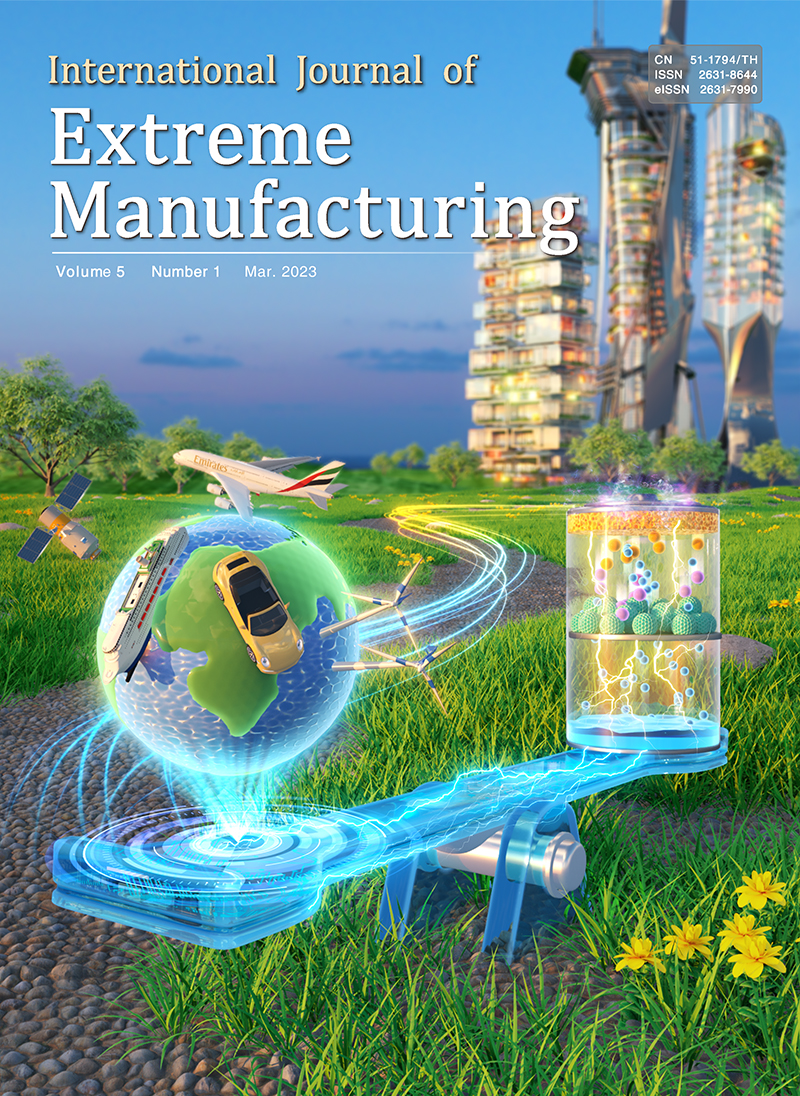RESEARCH ● OPEN ACCESS Read More
1. Introduction
Titanium alloy is one of the most important engineering materials used in the aerospace field. The development of novel titanium alloys with high strength is essential for meeting the lightweight and high-strength requirements of advanced aerospace engines. Laser aided additive manufacturing (LAAM) is a promising technique to fabricate such kind of engineering materials, and may bring new opportunities and challenges, due to its unique features of near-rapid melting and solidification. For instance, the typical microstructure of LAAM Ti-6Al-4V alloy is coarse columnar grain epitaxially growing along the building direction with the major-axis length of higher than 1 mm. Such kind of microstructure is not conducive to grain-boundary hardening according to Hall-Petch relation, which limits the improvement of strength. It is of great importance to address the issue of initial coarse microstructure for developing LAAM-customized titanium alloys with high strength and promoting the practical application of LAAM in aerospace. Recently, Dr. Shang Sui, Dr. Youxiang Chew, Dr. Fei Weng, Dr. Chaolin Tan, Dr. Zhenglin Du and Dr. Guijun Bi from Singapore Institute of Manufacturing Technology, SIMTech, wrote a research paper entitled ‘Study on Intrinsic Mechanisms of Nickel Additive for Grain Refinement and Strength Enhancement of Laser Aided Additively Manufactured Ti-6Al-4V’ on IJEM. In this paper, the authors systematically investigated the effect of Ni content on microstructural evolution and strength improvement of LAAM Ti-6Al-4V alloy.
As shown in Fig. 1, the in-situ Ni alloying demonstrates four effects on the microstructure of LAAM Ti-6Al-4V alloy. (i) Ni additive can remarkably refine the prior-β grains. (ii) Ni additive can discernibly induce the formation of globular α phase. (iii) Ni additive can induce the precipitation of Ti2Ni nanoparticle. (iv) Ni as a well-known β-stabilizer and it can remarkably increase the volume fraction of β phase. Room-temperature tensile results demonstrated an increase in mechanical strength and an almost linearly decreasing elongation with increasing Ni addition. A modified mathematical model was used for quantitative analysis of the strengthening mechanism. It was evident from the results that the α lath phase and the solid solutes contribute the most to the overall yield strength of LAAM-built Ti-6Al-4V-xNi alloys in this work.
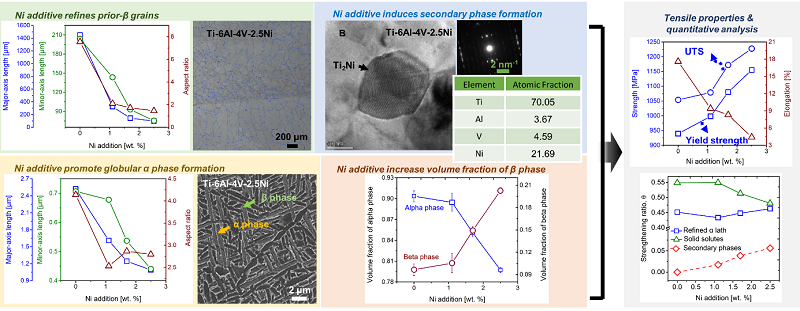
Figure 1. Microstructure and room-temperature tensile properties of LAAM Ti-6Al-4V-xNi alloys
Highlights
● Fabrication of free-defect Ti-6Al-4V-xNi alloys via LAAM was achieved.
● The intrinsic mechanisms of grain refinement and α phase globularization during LAAM of Ti-6Al-4V-xNi were clarified.
● The strengthening mechanism of LAAM Ti-6Al-4V-xNi alloys were quantitatively elaborated.
2. Background
Titanium alloys have been widely used in aerospace, automotive and medicine due to its low density, high specific strength and good corrosion resistance. In order to meet the requirements for lightweight and high performance, laser aided additive manufacturing (LAAM) technique, which is developed based on the principle of ‘discrete + accumulation’, has gradually shown broad application prospect in the fabrication of titanium structural parts. Typical microstructure of LAAM titanium alloys is epitaxially growing columnar grain. This microstructure characteristic brings about a strong<001>texture, which is generally accepted as the main reason for anisotropic mechanical properties and even reduction in strength. In this study, Dr. Shang Sui et al. took full advantage of the feature that ‘forming elements can be controlled in real time’ in the LAAM process, and adopted the in-situ Ni alloying method to refine the initial microstructure and improve the strength.
3. Results
1. Ni additive demonstrates the following four effects on the microstructure of LAAM Ti-6Al-4V alloy:
(i) With increasing Ni content, the morphology of prior-β grain of LAAM Ti-6Al-4V-xNi gradually changes from columnar to equiaxed, while the size decreases first and then increases, as shown in Fig. 2 and Fig. 3.
(ii) More globular α phase forms as the Ni content increases as shown in Fig. 4.
(iii) Ni additive induces the precipitation of Ti2Ni nanoparticle, as shown in Fig. 5.
(iv) Ni additive increases the content of β phase, while decreases the content of α phase, since it is a β-stabilizing element.
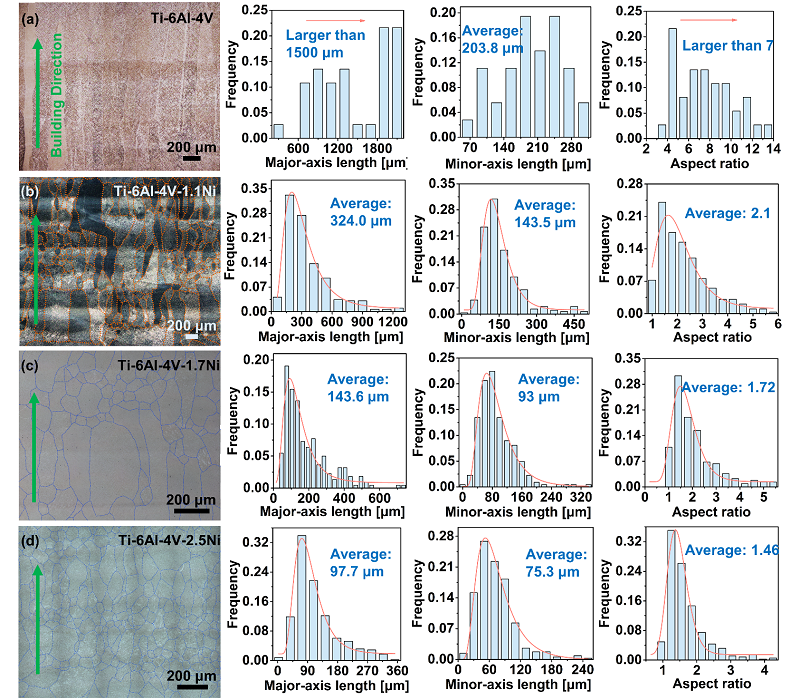
Figure 2. OM observation of prior-β grains and quantitative statistic results.(a) Ti-6Al-4V; (b) Ti-6Al-4V-1.1Ni; (c) Ti-6Al-4V-1.7Ni; (d) Ti-6Al-4V-2.5Ni.

Figure 3. Prior-β grain observation and quantitative statistic results of LAAM-built Ti-6Al-4V-3.6Ni (a-b) and Ti-6Al-4V-5.6Ni alloys (c-d).
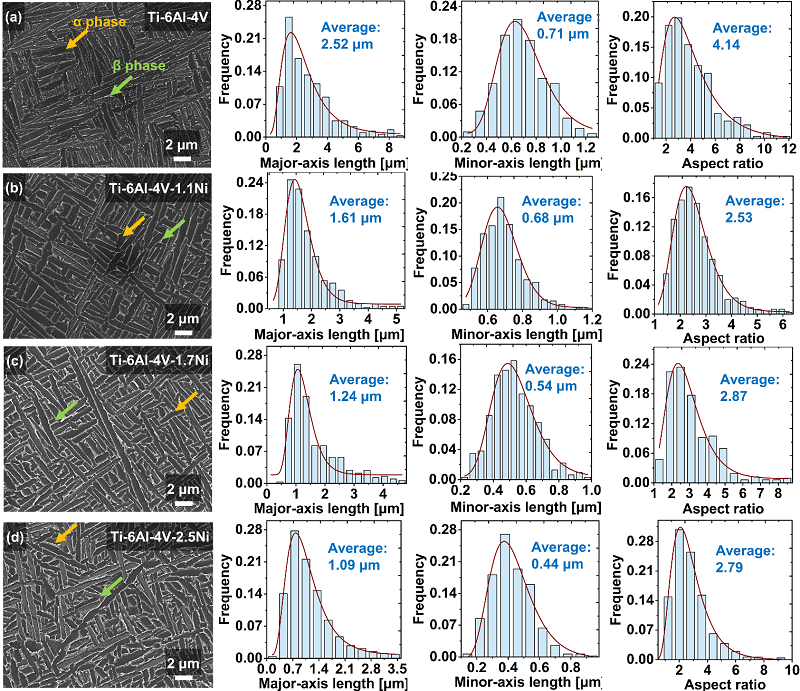
Figure 4. SEM observation of α laths and quantitative statistic results. (a) Ti-6Al-4V; (b) Ti-6Al-4V-1.1Ni; (c) Ti-6Al-4V-1.7Ni; (d) Ti-6Al-4V-2.5Ni.

Figure 5. TEM detected results of LAAM-built Ti-6Al-4V-xNi (x=1.1, 2.5 wt. %) alloys. (a) Ti2Ni nanoparticle in the Ti-6Al-4V-1.1Ni alloy. (b) Ti2Ni nanoparticle in the Ti-6Al-4V-2.5Ni alloy.
2. The yield strength and tensile strength of LAAM Ti-6Al-4V-xNi alloys increases linearly with the increase of Ni content, while the ductility shows an opposite trend, as shown in Fig. 6.
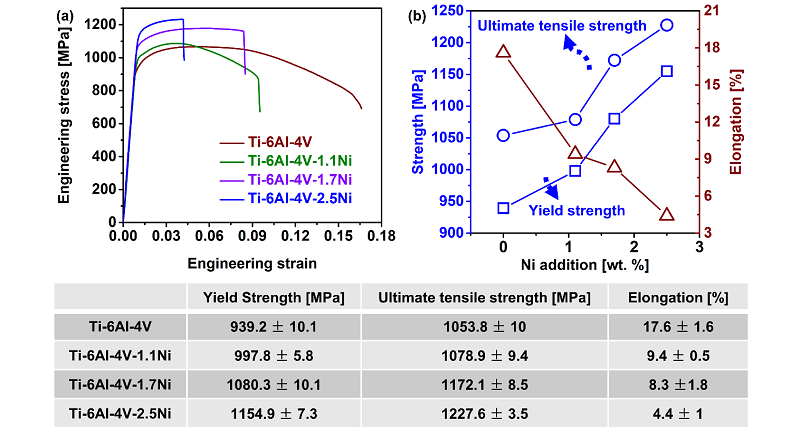
Figure 6. Room-temperature tensile properties of LAAM-built Ti-6Al-4V-xNi (x=0, 1.1, 1.7, 2.5 wt. %) alloys. (a) Engineering stress-strain curves; (b) Variation of strength and elongation with Ni addition.
4. Discussion
1. Effect of Ni addition on prior-β grain refinement
Ni additive can enhance the solidification range of Ti-6Al-4V alloy and enlarge its constitutional undercooling zone. Therefore, more nuclei can grow stably and become new grains in front of solid-liquid interface, thus hindering the epitaxial growth of the initial grains. Consequently, the final grains are refined, and their morphologies changes from columnar to equiaxed. With the increase of Ni content, the constitutional undercooling zone of Ti-6Al-4V-xNi alloy gradually becomes larger, resulting in more significant grain refinement effect, as shown in Fig. 7. However, the nucleation rate and growth rate show a trend of first increasing and then decreasing, with the increase in undercooling. Thereby, excessive Ni content may lead to an increase in grain size.
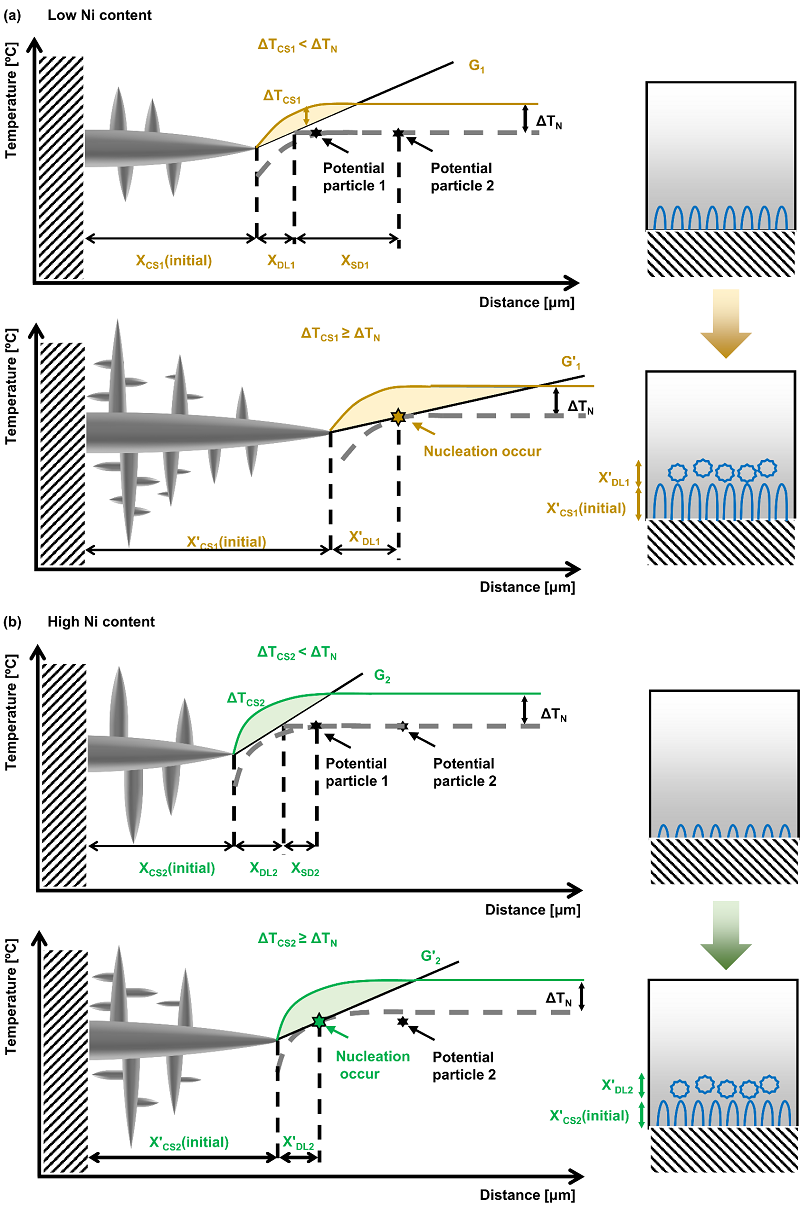
Figure 7. Schematic of effect of Ni content on grain refinement. (a) Low Ni content; (b) High Ni content.
2. Effect of Ni addition on the globularization of α phase
It is indicated by termination mass migration theory that the element diffusion between α and β phases is the main driving force for globularizing α phase. As shown in Fig. 8, the re-distribution of chemical elements between α and β phases occurs in the LAAM of Ti-6Al-4V-2.5Ni alloys due to cyclic heating effect. Specifically, the chemical compositions of the α and β phases in the top region are different from those in the middle region. It is evident that the most distinguished difference lies on Ni content. The ratio of Ni content in the α phase to the β phase in the top region is 1.0/1.7, while that in the middle region becomes 1.0/7.4, which means that Ni additive enhances the element diffusion between α and β phases and promotes the formation of globular α phase.
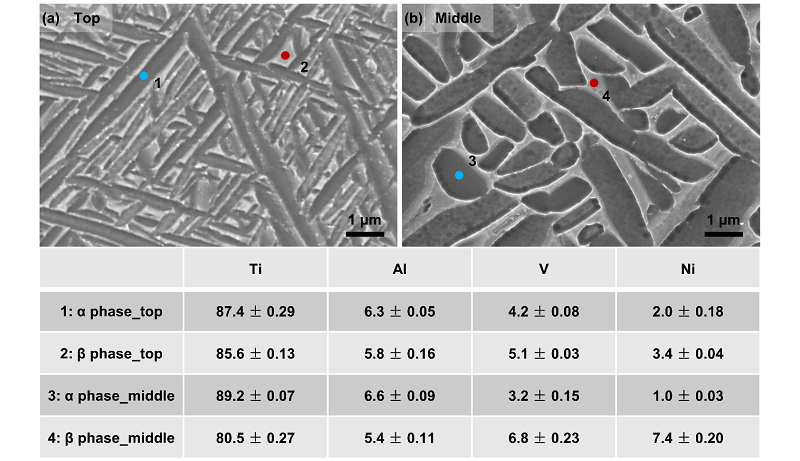
Figure 8. Chemical compositions (wt. %) of the α and β phases in the top (a) and middle regions (b) of LAAM Ti-6Al-4V-2.5Ni alloy.
3. Strengthening mechanism
A modified strengthening model was applied to quantitatively compute the yield strength. Four contributing factors, including prior-β grains, refined α lath, solid solutes and Ti2Ni nanoparticles, were considered. Quantitative analysis demonstrates that the strengthening effects of both the refined α lath phase and solid solutes dominate the contribution to overall yield strength of the LAAM-built Ti-6Al-4V-xNi (x=0, 1.1, 1.7, 2.5 wt. %) alloys as shown in Fig. 9a. With the increase of Ni content, the proportion of strengthening effect of refined α lath phase gradually increases, while that of solid solutes becomes smaller (Fig. 9b). Therefore, the yield strength variation with Ni addition can be directly estimated by the width of the α lath (Fig. 9c).
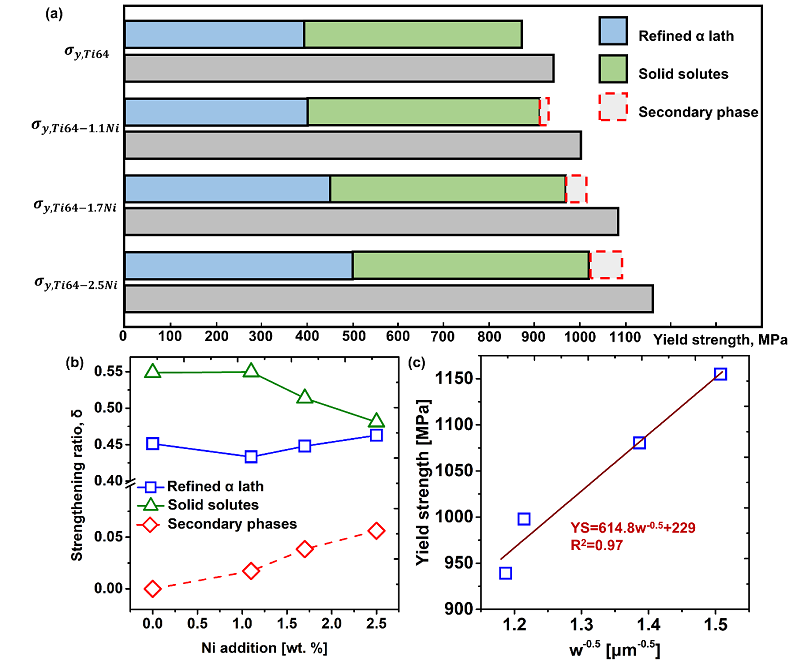
Figure 9. Quantitative analysis of strengthening mechanism of Ni addition on LAAM-built Ti-6Al-4V alloy. (a) Comparison of calculated results and experimental values for overall yield strength; (b) Variation of strengthening ratio with Ni addition; (c) Relationship between yield strength and α lath width.
4. Effect of Ni addition on decrease in elongation
As is well known, Ni is a β-stabilizing element, and will be enriched in the β phase. With the increase of Ni content, the dislocation movement resistance in the β phase becomes greater, which means that the solid solution hardening effect caused by the β phase is enhanced as shown in Fig. 10. The large amount of solid-solution Ni atoms in the β phase increase its strength significantly while reducing the material deformability. Considering that the α phase and the β phase are arranged alternately in the titanium alloys, the deterioration of the deformability of the β phase limits the deformation of the α phase, resulting in the decrease in elongation.

Figure 10. Solid solution effects caused by the α and β phases in the LAAM-built Ti-6Al-4V-xNi alloys (x=0, 1.1, 1.7, 2.5 wt.%)
5. Conclusion
In this work, the Ti-6Al-4V-xNi alloys (x=0, 1.1, 1.7, 2.5 wt. %) were successfully fabricated using laser aided additive manufacturing technology. The effects of Ni additive on the microstructural characteristics and mechanical properties of the deposited alloys were investigated. The results showed that the Ni additive had multi-scale effects on microstructure of LAAM Ti-6Al-4V alloy, including prior-β grain refinement (micron-scale), globular α phase formation (submicron-scale) and Ti2Ni particle precipitation (nano-scale). The strengthening mechanism was quantitatively analyzed by using a modified mathematical model. It was obvious that the strengthening effect caused by the α lath phase and the solid solutes predominated in the LAAM-built Ti-6Al-4V-xNi alloys. Furthermore, the decrease in elongation with increasing Ni addition is ascribed to the deterioration in deformability of the β phase caused by a large amount of solid-solution Ni atoms. These findings can accelerate the development of additively manufactured titanium alloys.
6. About the Authors

Dr. Shang Sui received his B.S. degree in Materials Forming and Control Engineering in 2013 as an outstanding graduate, his Ph.D. in Materials Processing Engineering in 2019, all from Northwestern Polytechnical University of China. From 2019.09 to 2021.09, he worked in Singapore Institute of Manufacturing Technology as a Research Scientist. He has been engaged in Laser Additive Manufacturing (LAM) technology for 6 years since 2013 when he was a bachelor student at Northwestern Polytechnical University. His research is focused on the microstructural optimization and mechanical performance enhancement of LAM-built nickel-based superalloys and titanium alloys.

Guijun Bi received his PhD in laser material processing from Fraunhofer Institute for Laser Technology and RWTH Aachen University, Germany in 2004. Currently Dr Bi is a Principal Scientist and Director with Institute of Intelligent Manufacturing (GIIM), Guangdong Academy of Sciences, China. Before joining GIIM, He was the Group Manager of Joining & Machining Group in Singapore Institute of Manufacturing Technology (SIMTech) and Principal Investigator of “Large Format Hybrid Laser Aided Additive Manufacturing” and “Advanced Laser Aided Additive Manufacturing & Hybrid Laser-arc Welding Technologies for Complex Marine & Offshore Structures” programs, under Agency for Science, Technology and Research (A*STAR), Singapore. His research area covers additive manufacturing, welding & joining, numerical simulation, process monitoring & control, machine learning, system and process development.







